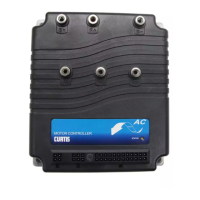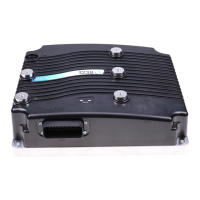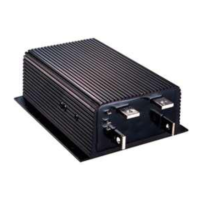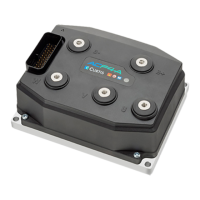Curtis 1243GEN2 Manual
42
throttle is applied after the KSI input has been received but before the interlock
switch is closed, the vehicle will accelerate to the requested speed as soon as the
interlock switch is closed.
SRO
The static return to off (SRO) feature prevents the vehicle from being started
when “in gear,” i.e., with a direction already selected. SRO checks the sequenc-
ing of the KSI and interlock inputs relative to a direction input. SRO faults can
result from using an incorrect sequence, or from using a correct sequence with
less than 50 msec between steps. If an SRO fault is declared, the controller will
inhibit output to the motor until the fault is cleared by using an acceptable
sequence.
The sequencing delay can be used to prevent SRO faults that would
otherwise occur from momentary opening of the interlock switch while driving
(see Figure 14, page 29). If the interlock switch is opened and then quickly
closed before the programmed delay time elapses, no SRO fault will be declared
and operation will not be interrupted.
Note: The conditions for SRO faults are not affected by whether the main
contactor interlock parameter is On or Off.
Three types of SRO are available, along with a “no SRO” option.
SRO Type 0
:
No SRO fault detection
SRO Type 1
:
KSI and Interlock before direction input
To drive the vehicle, the controller must receive both a KSI input and an
interlock input before receiving an input from either direction switch. The order
in which the KSI and interlock inputs are received does not matter, only that
they are both received before a direction input.
SRO Type 2
:
KSI before Interlock before direction input
To drive the vehicle, the controller must receive a KSI input and then an
interlock input before receiving an input from either direction switch.
SRO Type 3
:
KSI before Interlock before forward input
Type 3 SRO is useful for walkie vehicles that frequently operate on ramps. To drive
the vehicle in the forward direction, the controller must receive the KSI, interlock,
and forward inputs in that order, as in SRO Type 2. However, this sequence is
not required for operation in reverse. With SRO Type 3, a reverse input is
allowed at any place in the sequence: i.e., before interlock, or even before KSI.
SEQUENCING DLY
The sequencing delay feature allows the interlock switch to be cycled within a
set time—the sequencing delay—without activating HPD or SRO. This
feature is useful in applications where the interlock switch may bounce or be
3 — PROGRAMMABLE PARAMETERS:
Sequencing Fault Parameters
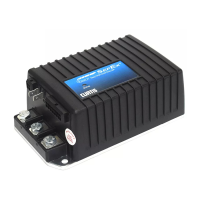
